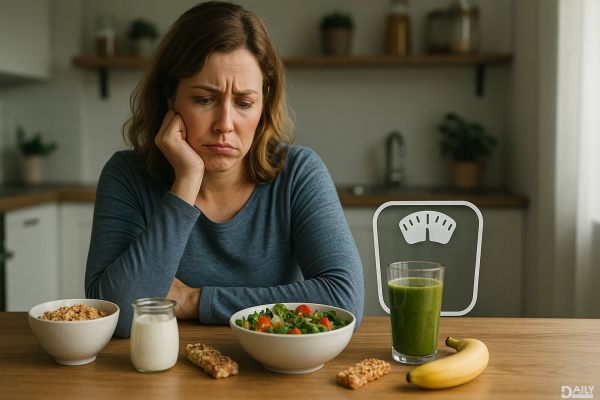You might think you're making smart choices by reaching for those so-called "healthy" foods, but some of them could be secretly sabotaging your waistline. Yep, even the stuff that’s marketed as good-for-you can pack on the pounds if you’re not careful. Let’s break down 10 foods that might be tricking you into thinking they’re harmless—and what you can do to stay on track.

Smoothies seem like the ultimate health hack, right? Blend up some fruit, maybe toss in some spinach, and boom—you’ve got a nutrient-packed meal. But here’s the catch: many smoothies, especially the store-bought ones, are loaded with added sugars and calorie-dense ingredients like syrups, nut butters, and full-fat yogurt. Even homemade versions can go overboard if you’re not mindful of portion sizes. A large smoothie can easily clock in at 500+ calories, which is more like a meal than a snack. To keep it healthy, stick to whole fruits, unsweetened almond milk, and a modest scoop of protein powder.
Granola has this wholesome, crunchy reputation, but it’s often a calorie bomb in disguise. Many brands are packed with sugar, oil, and dried fruit, which can make a small serving surprisingly high in calories. A half-cup of granola can contain upwards of 200 calories, and let’s be real—who stops at just half a cup? If you’re a granola lover, opt for low-sugar varieties or make your own at home using oats, nuts, and a touch of honey. And remember, portion control is key.
Trail mix is the go-to snack for hikers and health enthusiasts, but it’s easy to overdo it. Nuts, seeds, and dried fruit are nutrient-dense, but they’re also calorie-dense. A handful here and there can quickly add up, especially if your mix includes chocolate chips or candies. To keep it in check, portion out single servings instead of eating straight from the bag. Or better yet, make your own mix with unsalted nuts, seeds, and a small amount of dark chocolate for a healthier alternative.
Protein bars are marketed as the perfect on-the-go snack, but many of them are more like candy bars in disguise. They can be loaded with sugar, artificial ingredients, and unhealthy fats. Some bars contain as much sugar as a candy bar, which can spike your blood sugar and leave you craving more. When choosing a protein bar, look for ones with minimal ingredients, low sugar content, and at least 10 grams of protein. Or, skip the bar altogether and grab a handful of nuts or a hard-boiled egg instead.
Avocado toast has become a breakfast staple, and for good reason—avocados are packed with healthy fats and fiber. But here’s the thing: avocados are also high in calories. One medium avocado contains around 240 calories, and when you add a slice of bread and toppings like olive oil or cheese, the calorie count can skyrocket. To keep it balanced, use half an avocado and pair it with whole-grain bread and a sprinkle of sea salt or red pepper flakes for flavor.
Yogurt parfaits look like the epitome of health, with layers of yogurt, fruit, and granola. But many store-bought versions are loaded with sugary yogurt and sweetened granola, turning a seemingly healthy snack into a dessert. Even Greek yogurt, which is often touted as a healthier option, can be high in sugar if it’s flavored. To make a healthier parfait, use plain Greek yogurt, fresh fruit, and a small amount of unsweetened granola or nuts.
Veggie chips sound like a healthier alternative to potato chips, but don’t be fooled. Many brands are still fried and loaded with salt and unhealthy fats. Plus, they often contain less fiber and nutrients than you’d get from actual vegetables. If you’re craving something crunchy, try making your own veggie chips at home by baking thinly sliced vegetables like zucchini, kale, or sweet potatoes. Or, just grab a handful of raw veggies with hummus for a truly healthy snack.
Dried fruit is a convenient way to get your fruit fix, but it’s also a concentrated source of calories and sugar. Because the water has been removed, dried fruit is much denser than fresh fruit, meaning you’re consuming more calories in a smaller portion. For example, a cup of raisins has nearly 500 calories, compared to about 100 calories in a cup of grapes. To keep it in check, stick to small portions and pair dried fruit with a source of protein or healthy fat, like nuts or cheese, to balance out the sugar.
Gluten-free products have gained popularity, but they’re not necessarily healthier—or lower in calories. In fact, many gluten-free baked goods are made with refined flours and added sugars to improve texture and taste. If you’re not gluten-intolerant, there’s no need to avoid gluten. Instead, focus on whole, unprocessed foods like fruits, vegetables, lean proteins, and whole grains, which are naturally gluten-free and packed with nutrients.
Salads are often seen as the ultimate healthy meal, but they can quickly become a calorie bomb if you’re not careful. Creamy dressings, croutons, cheese, and fried toppings can turn a light salad into a high-calorie meal. For example, a Caesar salad with dressing and croutons can contain over 500 calories. To keep your salad healthy, stick to a base of leafy greens, add plenty of colorful veggies, and use a light vinaigrette or lemon juice for dressing. And go easy on the high-calorie toppings.
So, there you have it—10 "healthy" foods that might not be as innocent as they seem. The key is to stay informed, read labels, and practice portion control. Just because something is marketed as healthy doesn’t mean it’s a free pass to eat as much as you want. By making smarter choices and being mindful of what you’re putting into your body, you can enjoy these foods without packing on the pounds. Stay savvy, folks!
























